engine YAMAHA CYGNUS L 2012 Owner's Guide
[x] Cancel search | Manufacturer: YAMAHA, Model Year: 2012, Model line: CYGNUS L, Model: YAMAHA CYGNUS L 2012Pages: 76, PDF Size: 1.56 MB
Page 56 of 76

PERIODIC MAINTENANCE AND ADJUSTMENT
6-21
6
EAU22721
Changing the brake fluid Have a Yamaha dealer change the
brake fluid at the intervals specified in
the TIP after the periodic maintenance
and lubrication chart. In addition, have
the oil seals of the brake master cylin-
der and caliper as well as the brake
hose replaced at the intervals listed be-
low or whenever they are damaged or
leaking.●
Oil seals: Replace every two
years.
●
Brake hose: Replace every four
years.
EAU23095
Checking and lubricating the
cables The operation of all control cables and
the condition of the cables should be
checked before each ride, and the ca-
bles and cable ends should be lubricat-
ed if necessary. If a cable is damaged
or does not move smoothly, have a
Yamaha dealer check or replace it.
WARNING! Damage to the outer
housing of cables may result in in-
ternal rusting and cause interfer-
ence with cable movement. Replace
damaged cables as soon as possi-
ble to prevent unsafe conditions.[EWA10711]EAU23114
Checking and lubricating the
throttle grip and cable The operation of the throttle grip should
be checked before each ride. In addi-
tion, the cable should be lubricated by a
Yamaha dealer at the intervals speci-
fied in the periodic maintenance chart.
The throttle cable is equipped with a
rubber cover. Make sure that the cover
is securely installed. Even though the
cover is installed correctly, it does not
completely protect the cable from water
entry. Therefore, use care not to pour
water directly onto the cover or cable
when washing the vehicle. If the cable
or cover becomes dirty, wipe clean with
a moist cloth.
Recommended lubricant:
Yamaha Chain and Cable Lube or
engine oil
U1RSE0E0.book Page 21 Tuesday, October 18, 2011 8:56 AM
Page 65 of 76
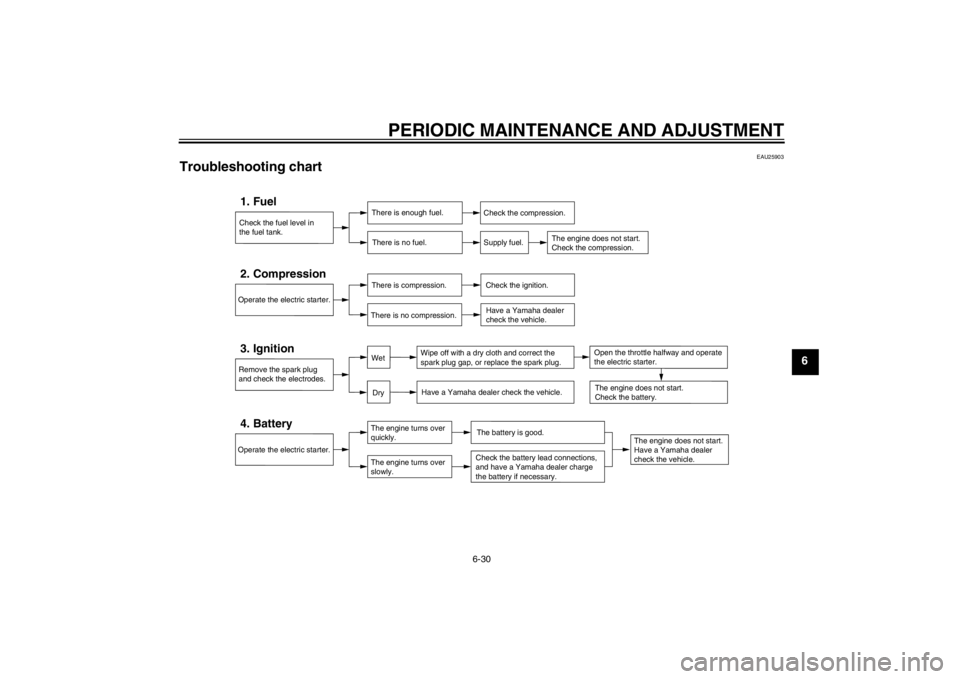
PERIODIC MAINTENANCE AND ADJUSTMENT
6-30
6
EAU25903
Troubleshooting chart
Check the fuel level in
the fuel tank.1. Fuel
There is enough fuel.
There is no fuel.
Check the compression.
Supply fuel.
The engine does not start.
Check the compression.
Operate the electric starter.2. Compression
There is compression.
There is no compression.
Check the ignition.
Have a Yamaha dealer
check the vehicle.
Remove the spark plug
and check the electrodes.3. Ignition
Wipe off with a dry cloth and correct the
spark plug gap, or replace the spark plug.
Have a Yamaha dealer check the vehicle.
The engine does not start.
Have a Yamaha dealer
check the vehicle.
The engine does not start.
Check the battery.
Operate the electric starter.4. Battery
The engine turns over
quickly.
The engine turns over
slowly.
The battery is good.Check the battery lead connections,
and have a Yamaha dealer charge
the battery if necessary.
DryWet
Open the throttle halfway and operate
the electric starter.
U1RSE0E0.book Page 30 Tuesday, October 18, 2011 8:56 AM
Page 66 of 76

SCOOTER CARE AND STORAGE
7-1
7
EAU37833
Matte color caution NOTICE
ECA15192
Some models are equipped with
matte colored finished parts. Be
sure to consult a Yamaha dealer for
advice on what products to use be-
fore cleaning the vehicle. Using a
brush, harsh chemical products or
cleaning compounds when cleaning
these parts will scratch or damage
their surface. Wax also should not
be applied to any matte colored fin-
ished parts.
EAU26094
Care While the open design of a scooter re-
veals the attractiveness of the technol-
ogy, it also makes it more vulnerable.
Rust and corrosion can develop even if
high-quality components are used. A
rusty exhaust pipe may go unnoticed
on a car, however, it detracts from the
overall appearance of a scooter. Fre-
quent and proper care does not only
comply with the terms of the warranty,
but it will also keep your scooter looking
good, extend its life and optimize its
performance.
Before cleaning
1. Cover the muffler outlet with a
plastic bag after the engine has
cooled down.
2. Make sure that all caps and covers
as well as all electrical couplers
and connectors, including the
spark plug cap, are tightly in-
stalled.
3. Remove extremely stubborn dirt,
like oil burnt onto the crankcase,
with a degreasing agent and a
brush, but never apply such prod-ucts onto seals, gaskets and wheel
axles. Always rinse the dirt and de-
greaser off with water.
Cleaning
NOTICE
ECA10783
●
Avoid using strong acidic wheel
cleaners, especially on spoked
wheels. If such products are
used on hard-to-remove dirt, do
not leave the cleaner on the af-
fected area any longer than in-
structed. Also, thoroughly rinse
the area off with water, immedi-
ately dry it, and then apply a cor-
rosion protection spray.
●
Improper cleaning can damage
plastic parts (such as cowlings,
panels, windshields, headlight
lenses, meter lenses, etc.) and
the mufflers. Use only a soft,
clean cloth or sponge with wa-
ter to clean plastic. However, if
the plastic parts cannot be thor-
oughly cleaned with water, di-
luted mild detergent with water
may be used. Be sure to rinse
U1RSE0E0.book Page 1 Tuesday, October 18, 2011 8:56 AM
Page 68 of 76
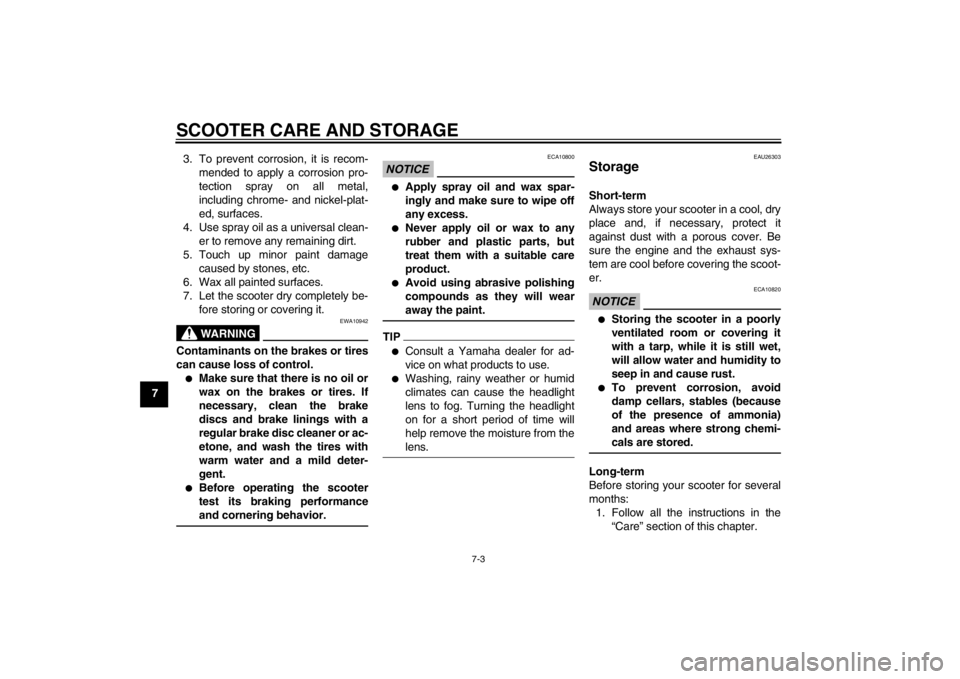
SCOOTER CARE AND STORAGE
7-3
73. To prevent corrosion, it is recom-
mended to apply a corrosion pro-
tection spray on all metal,
including chrome- and nickel-plat-
ed, surfaces.
4. Use spray oil as a universal clean-
er to remove any remaining dirt.
5. Touch up minor paint damage
caused by stones, etc.
6. Wax all painted surfaces.
7. Let the scooter dry completely be-
fore storing or covering it.
WARNING
EWA10942
Contaminants on the brakes or tires
can cause loss of control.●
Make sure that there is no oil or
wax on the brakes or tires. If
necessary, clean the brake
discs and brake linings with a
regular brake disc cleaner or ac-
etone, and wash the tires with
warm water and a mild deter-
gent.
●
Before operating the scooter
test its braking performance
and cornering behavior.
NOTICE
ECA10800
●
Apply spray oil and wax spar-
ingly and make sure to wipe off
any excess.
●
Never apply oil or wax to any
rubber and plastic parts, but
treat them with a suitable care
product.
●
Avoid using abrasive polishing
compounds as they will wear
away the paint.
TIP●
Consult a Yamaha dealer for ad-
vice on what products to use.
●
Washing, rainy weather or humid
climates can cause the headlight
lens to fog. Turning the headlight
on for a short period of time will
help remove the moisture from the
lens.
EAU26303
Storage Short-term
Always store your scooter in a cool, dry
place and, if necessary, protect it
against dust with a porous cover. Be
sure the engine and the exhaust sys-
tem are cool before covering the scoot-
er.NOTICE
ECA10820
●
Storing the scooter in a poorly
ventilated room or covering it
with a tarp, while it is still wet,
will allow water and humidity to
seep in and cause rust.
●
To prevent corrosion, avoid
damp cellars, stables (because
of the presence of ammonia)
and areas where strong chemi-
cals are stored.
Long-term
Before storing your scooter for several
months:
1. Follow all the instructions in the
“Care” section of this chapter.
U1RSE0E0.book Page 3 Tuesday, October 18, 2011 8:56 AM
Page 69 of 76
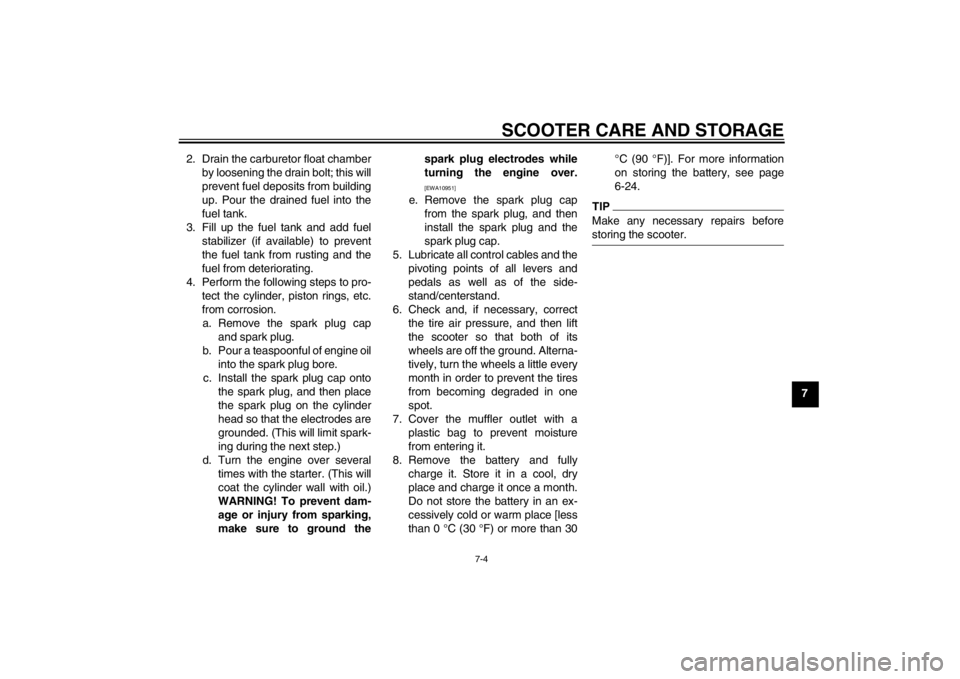
SCOOTER CARE AND STORAGE
7-4
7 2. Drain the carburetor float chamber
by loosening the drain bolt; this will
prevent fuel deposits from building
up. Pour the drained fuel into the
fuel tank.
3. Fill up the fuel tank and add fuel
stabilizer (if available) to prevent
the fuel tank from rusting and the
fuel from deteriorating.
4. Perform the following steps to pro-
tect the cylinder, piston rings, etc.
from corrosion.
a. Remove the spark plug cap
and spark plug.
b. Pour a teaspoonful of engine oil
into the spark plug bore.
c. Install the spark plug cap onto
the spark plug, and then place
the spark plug on the cylinder
head so that the electrodes are
grounded. (This will limit spark-
ing during the next step.)
d. Turn the engine over several
times with the starter. (This will
coat the cylinder wall with oil.)
WARNING! To prevent dam-
age or injury from sparking,
make sure to ground thespark plug electrodes while
turning the engine over.
[EWA10951]
e. Remove the spark plug cap
from the spark plug, and then
install the spark plug and the
spark plug cap.
5. Lubricate all control cables and the
pivoting points of all levers and
pedals as well as of the side-
stand/centerstand.
6. Check and, if necessary, correct
the tire air pressure, and then lift
the scooter so that both of its
wheels are off the ground. Alterna-
tively, turn the wheels a little every
month in order to prevent the tires
from becoming degraded in one
spot.
7. Cover the muffler outlet with a
plastic bag to prevent moisture
from entering it.
8. Remove the battery and fully
charge it. Store it in a cool, dry
place and charge it once a month.
Do not store the battery in an ex-
cessively cold or warm place [less
than 0 °C (30 °F) or more than 30°C (90 °F)]. For more information
on storing the battery, see page
6-24.
TIPMake any necessary repairs before
storing the scooter.
U1RSE0E0.book Page 4 Tuesday, October 18, 2011 8:56 AM
Page 70 of 76
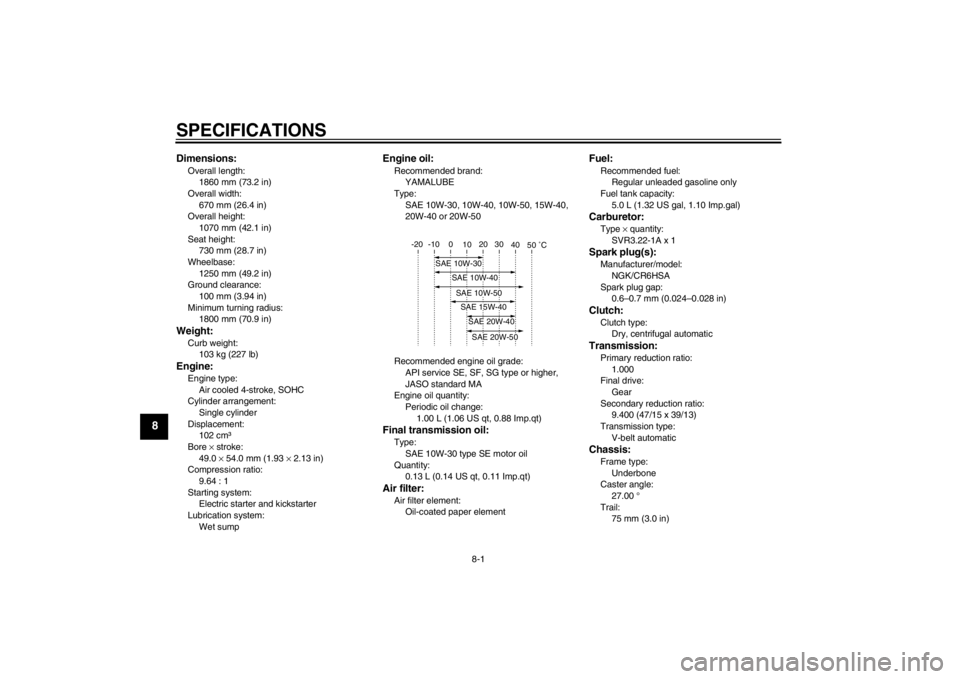
SPECIFICATIONS
8-1
8
Dimensions:Overall length:
1860 mm (73.2 in)
Overall width:
670 mm (26.4 in)
Overall height:
1070 mm (42.1 in)
Seat height:
730 mm (28.7 in)
Wheelbase:
1250 mm (49.2 in)
Ground clearance:
100 mm (3.94 in)
Minimum turning radius:
1800 mm (70.9 in)Weight:Curb weight:
103 kg (227 lb)Engine:Engine type:
Air cooled 4-stroke, SOHC
Cylinder arrangement:
Single cylinder
Displacement:
102 cm³
Bore × stroke:
49.0 × 54.0 mm (1.93 × 2.13 in)
Compression ratio:
9.64 : 1
Starting system:
Electric starter and kickstarter
Lubrication system:
Wet sump
Engine oil:Recommended brand:
YAMALUBE
Type:
SAE 10W-30, 10W-40, 10W-50, 15W-40,
20W-40 or 20W-50
Recommended engine oil grade:
API service SE, SF, SG type or higher,
JASO standard MA
Engine oil quantity:
Periodic oil change:
1.00 L (1.06 US qt, 0.88 Imp.qt)Final transmission oil:Type:
SAE 10W-30 type SE motor oil
Quantity:
0.13 L (0.14 US qt, 0.11 Imp.qt)Air filter:Air filter element:
Oil-coated paper element
Fuel:Recommended fuel:
Regular unleaded gasoline only
Fuel tank capacity:
5.0 L (1.32 US gal, 1.10 Imp.gal)Carburetor:Type × quantity:
SVR3.22-1A x 1Spark plug(s):Manufacturer/model:
NGK/CR6HSA
Spark plug gap:
0.6–0.7 mm (0.024–0.028 in)Clutch:Clutch type:
Dry, centrifugal automaticTransmission:Primary reduction ratio:
1.000
Final drive:
Gear
Secondary reduction ratio:
9.400 (47/15 x 39/13)
Transmission type:
V-belt automaticChassis:Frame type:
Underbone
Caster angle:
27.00 °
Trail:
75 mm (3.0 in)
-20 -10 0
10 20 30
40
50 ˚C
SAE 10W-30
SAE 15W-40SAE 20W-40SAE 20W-50
SAE 10W-40SAE 10W-50
U1RSE0E0.book Page 1 Tuesday, October 18, 2011 8:56 AM
Page 71 of 76

SPECIFICATIONS
8-2
8
Front tire:Type:
Tubeless
Size:
100/90-10 56J
Manufacturer/model:
CHENG SHIN/C-922-XRear tire:Type:
Tubeless
Size:
100/90-10 56J
Manufacturer/model:
CHENG SHIN/C-940-XLoading:Maximum load:
165 kg (364 lb)
(Total weight of rider, passenger, cargo and
accessories)Tire air pressure (measured on cold
tires):Loading condition:
0–75 kg (0–165 lb)
Front:
175 kPa (1.75 kgf/cm², 25 psi)
Rear:
250 kPa (2.50 kgf/cm², 36 psi)
Loading condition:
75–153 kg (165–337 lb)
Front:
175 kPa (1.75 kgf/cm², 25 psi)
Rear:
250 kPa (2.50 kgf/cm², 36 psi)
Front wheel:Wheel type:
Cast wheel
Rim size:
J10 x MT2.15Rear wheel:Wheel type:
Cast wheel
Rim size:
J10 x MT2.50Front brake:Type:
Single disc brake
Operation:
Right hand operation
Specified brake fluid:
DOT 3 or 4Rear brake:Type:
Drum brake
Operation:
Left hand operationFront suspension:Type:
Telescopic fork
Spring/shock absorber type:
Coil spring/oil damper
Wheel travel:
80.0 mm (3.15 in)Rear suspension:Type:
Unit swing
Spring/shock absorber type:
Coil spring/oil damperWheel travel:
63.0 mm (2.48 in)
Electrical system:Ignition system:
DC CDI
Charging system:
AC magnetoBattery:Model:
YTX7A-BS
Voltage, capacity:
12 V, 6.0 AhHeadlight:Bulb type:
IncandescenceBulb voltage, wattage × quantity:Headlight:
12 V, 35 W/35 W × 1
Tail/brake light:
12 V, 5.0 W/21.0 W × 1
Front turn signal light:
12 V, 10.0 W × 2
Rear turn signal light:
12 V, 16.0 W × 2
Auxiliary light:
12 V, 3.0 W × 1
Meter lighting:
12 V, 3.4 W × 2
High beam indicator light:
12 V, 1.7 W × 1
Turn signal indicator light:
12 V, 1.7 W × 1
Engine trouble warning light:
12 V, 3.4 W × 1
U1RSE0E0.book Page 2 Tuesday, October 18, 2011 8:56 AM
Page 73 of 76
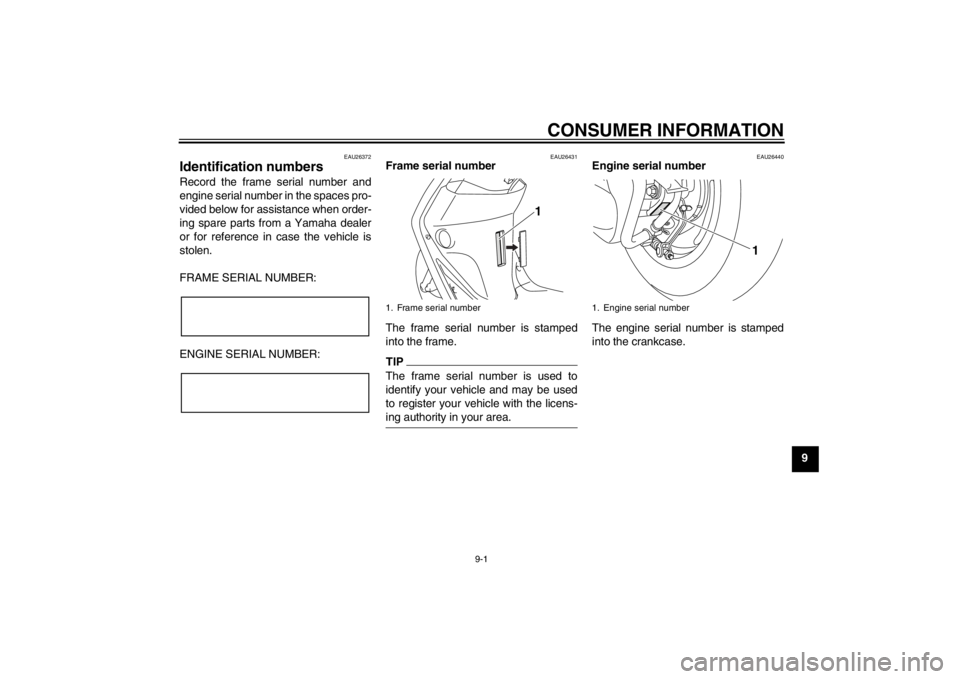
CONSUMER INFORMATION
9-1
9
EAU26372
Identification numbers Record the frame serial number and
engine serial number in the spaces pro-
vided below for assistance when order-
ing spare parts from a Yamaha dealer
or for reference in case the vehicle is
stolen.
FRAME SERIAL NUMBER:
ENGINE SERIAL NUMBER:
EAU26431
Frame serial number
The frame serial number is stamped
into the frame.TIPThe frame serial number is used to
identify your vehicle and may be used
to register your vehicle with the licens-
ing authority in your area.
EAU26440
Engine serial number
The engine serial number is stamped
into the crankcase.
1. Frame serial number
1
1. Engine serial number
1
U1RSE0E0.book Page 1 Tuesday, October 18, 2011 8:56 AM
Page 74 of 76

INDEXAAcceleration and deceleration................. 5-2
Air filter and V-belt case air filter
elements ............................................. 6-13
Auxiliary light bulb, replacing ................ 6-28BBattery................................................... 6-24
Brake fluid, changing ............................ 6-21
Brake fluid level, checking .................... 6-20
Brake lever, front..................................... 3-5
Brake lever, rear ..................................... 3-5
Brake levers, lubricating........................ 6-22
Brake pads and shoes, checking .......... 6-19
Braking .................................................... 5-2CCables, checking and lubricating .......... 6-21
Care ........................................................ 7-1
Carrier ................................................... 3-11
Catalytic converters ................................ 3-7
Centerstand and sidestand,
checking and lubricating ..................... 6-22
Cowlings and panels,
removing and installing ......................... 6-7DDimmer switch ........................................ 3-4EEngine break-in ....................................... 5-3
Engine idling speed, checking .............. 6-15
Engine oil .............................................. 6-10
Engine serial number .............................. 9-1
Engine trouble warning light.................... 3-3FFinal transmission oil ............................ 6-12
Frame serial number ............................... 9-1Front brake lever free play, checking ... 6-18
Front fork, checking .............................. 6-23
Fuel......................................................... 3-6
Fuel consumption, tips for reducing........ 5-3
Fuel gauge.............................................. 3-4
Fuel tank cap .......................................... 3-5
Fuse, replacing ..................................... 6-26
GGrab bar ............................................... 3-11HHandlebar switches ................................ 3-4
Headlight bulb, replacing ...................... 6-26
Helmet holders ....................................... 3-9
High beam indicator light ........................ 3-2
Horn switch ............................................. 3-4IIdentification numbers ............................ 9-1
Ignition circuit cut-off system ................ 3-12
Indicator lights and warning light ............ 3-2KKeyhole cover ......................................... 3-2
Kickstarter............................................... 3-8LLuggage hook ....................................... 3-11MMain switch/steering lock........................ 3-1
Maintenance and lubrication, periodic .... 6-4
Maintenance, emission control system... 6-3
Matte color, caution ................................ 7-1PParking ................................................... 5-4
Part locations .......................................... 2-1RRear brake lever free play, adjusting .... 6-18Rear turn signal light and
tail/brake light...................................... 6-28
SSafe-riding points .................................... 1-5
Safety information ................................... 1-1
Seat ......................................................... 3-8
Self-diagnosis device .............................. 3-3
Sidestand .............................................. 3-12
Spark plug, checking ............................... 6-9
Specifications .......................................... 8-1
Speedometer unit .................................... 3-3
Starting off ............................................... 5-2
Starting the engine .................................. 5-1
Start switch.............................................. 3-4
Steering, checking................................. 6-24
Storage.................................................... 7-3
Storage compartments ............................ 3-9TThrottle grip and cable,
checking and lubricating ..................... 6-21
Throttle grip free play, checking ............ 6-15
Tires ...................................................... 6-16
Troubleshooting .................................... 6-29
Troubleshooting chart ........................... 6-30
Turn signal indicator light ........................ 3-2
Turn signal light bulb (front),
replacing ............................................. 6-27
Turn signal switch ................................... 3-4VValve clearance..................................... 6-15WWheel bearings, checking ..................... 6-24
Wheels .................................................. 6-17
U1RSE0E0.book Page 1 Tuesday, October 18, 2011 8:56 AM